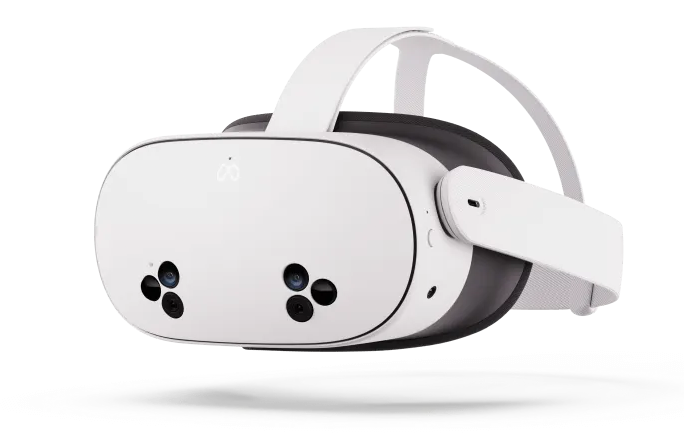
Meta Connect 2024 marked a notable step in the evolution of spatial computing, signaling a clear strategy to move from niche technology toward mainstream adoption. The event's keynotes showcased a three-pronged approach: democratize mixed reality with the Meta Quest 3S, define the future of augmented reality with the Orion AR glasses prototype, and infuse everyday wearables with AI through enhanced Ray-Ban Meta smart glasses.
For businesses, these announcements were not just about new hardware; they signaled the maturation of a new platform for customer engagement, training, and operations.
Quest 3S: Mass-Market Mixed Reality
The standout announcement was the Meta Quest 3S. With an accessible price point, it was positioned to expand the user base for high-quality mixed reality. The device retained core technologies that make the Quest platform useful for business applications:
- High-Fidelity Passthrough: Stereoscopic color passthrough allows users to see their physical environment clearly, enabling a seamless integration of virtual objects into their real-world space.
- Performance: Powered by the Snapdragon XR2 Gen 2 processor, the Quest 3S can handle demanding games, high-resolution media, and complex business applications.
- App Compatibility: It runs the entire existing library of Quest 2 and Quest 3 apps, ensuring a rich content ecosystem from day one.
Orion AR Glasses and AI-Powered Ray-Bans
While the Quest 3S targeted immersive sessions, the Orion AR glasses prototype and updated Ray-Bans illustrated a vision for persistent, all-day spatial computing.
- Orion: The True AR Vision: The Orion AR glasses prototype represented the long-term goal of AR: a device that looks and feels like normal glasses but can overlay contextual digital information onto the world.
- Ray-Ban Meta: The AI Bridge: The AI-enhanced Ray-Bans served as a practical bridge to that future, acclimating users to smart glasses before true AR is ready for the mass market.
Impact on Immersive Business Applications
The synergy between Meta's hardware advancements and platforms like Matterport creates value for businesses preparing for a more immersive future.
- A Growing, Accessible Audience: The affordability of the Quest 3S means more of your customers and employees own a device capable of true immersion. It's now possible to experience Matterport digital twins on these standalone (formerly Oculus) headsets. While the visual quality can be lower than on a powerful desktop, the sense of presence and scale it provides is a game-changer.
- Enhanced Training and Onboarding: Businesses can use accessible headsets to place new employees inside a virtual replica of a facility or process for training, without disrupting real-world operations.
- The Future of Remote Collaboration: The growing power of XR hardware makes the vision of architects and clients walking through a Matterport model together in a shared virtual space more tangible.
An Eye on Connect 2025: What the Official Agenda Reveals
With Meta Connect 2025 just ten days away (September 17-18), the official agenda provides a clear roadmap of what to expect. If 2024 was about getting powerful, affordable hardware into the hands of millions, 2025 is about empowering developers and businesses to build on that foundation.
- The Focus is on AI and Glasses: Mark Zuckerberg's keynote will focus on "AI glasses," confirming that the vision for Orion and the evolution of Ray-Ban smart glasses is central to Meta's strategy. The "future of computing" session further doubles down on this, promising a look at "glasses with contextual AI."
- A Major Push for Developers: The agenda is packed with developer sessions. The most significant for business may be "Your Android app, now in VR: Meta Horizon OS integration." This signals a massive effort to lower the barrier to entry, allowing businesses to bring their existing mobile applications into an immersive environment more easily.
- Building the Software Ecosystem: With numerous sessions on the "Meta Horizon Creator Program," "GenAI tools," and "spatial SDK," it's clear Meta is shifting from just selling headsets to building a robust, sustainable software and content ecosystem for creators and enterprise clients.
For businesses, the key takeaway is this: the platform is maturing. The tools to create practical, immersive applications for training, collaboration, and customer experiences are becoming more accessible than ever before.
Conclusion
Meta Connect 2024 made it clear that immersive technology is moving from the fringe to the forefront. As we look ahead to the 2025 event, the focus is shifting from hardware adoption to ecosystem development. For businesses, developing a strategy for how digital twins and immersive experiences fit into their operations is no longer a futuristic exercise, but a present-day consideration. The hardware is accessible, the platforms are maturing, and the audience is ready.